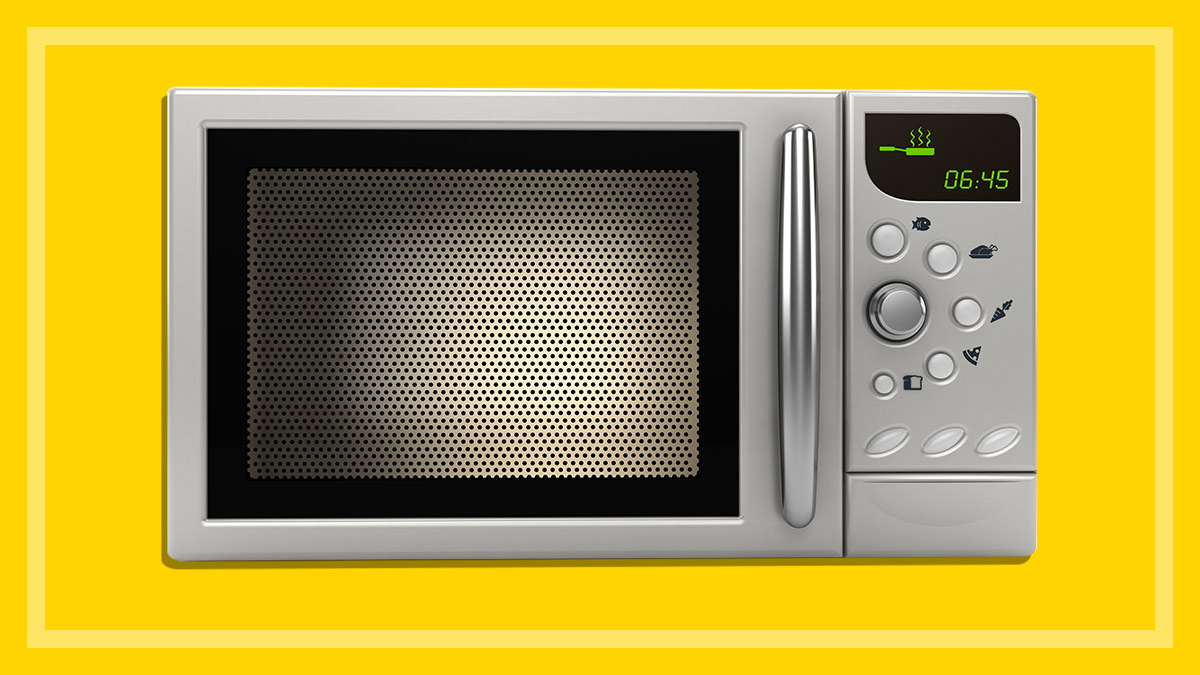Get our independent lab tests, expert reviews and honest advice.
What is an inverter microwave?

Need to know
- The difference between inverter and regular microwaves is in the way power is delivered
- Inverter microwaves provide a constant stream of power for the entire cooking time to avoid overheating
- Understanding the importance of power levels and how to use a microwave properly will go a long way towards getting great cooking results
On this page:
- How do inverter microwaves work?
- Inverter vs conventional microwave: What's the difference?
- What are the benefits of an inverter microwave?
- Are inverter microwaves more cost effective to run?
- The importance of power levels when using a microwave
- Is an inverter microwave worth it?
- Which brands offer inverter microwaves?
Microwaves tend to be a staple item in any kitchen – you can use them to reheat leftovers, defrost meat or cook veggies and rice. When it comes to shopping for one, there are standard microwaves and then there are inverter microwaves that claim superior performance.
But what’s the difference between the two and do inverter microwaves actually perform better? We’ve been assessing microwave performance for over 40 years and have put many microwaves to the test in our labs. Here’s what we’ve found.
How do inverter microwaves work?
An inverter microwave works by heating, reheating or defrosting food at a constant power level for the duration of the cooking time.
The aim of inverter technology is to provide a controlled and efficient power supply operating continuously at the same power to avoid overheating, loss of flavour and destroying food structure.
Inverter vs conventional microwave: What’s the difference?
The difference between inverter and conventional microwaves mainly comes down to the way power is supplied.
Conventional microwaves use a transformer that turns the power on and off (when the power setting is less than 100% or high) to give the food a chance to distribute heat. You’ll usually hear the microwave cutting in and out.
For example, if you set the microwave to deliver 50% power, it will actually go through cycles of producing 100% power followed by a period of no power to achieve the 50%.
Inverter microwaves supply power through an inverter circuit to supply a steady and constant amount of power throughout the cooking time without cutting in and out. So if you select 50% power, the microwave will deliver 50% power throughout.
Power levels for certain foods
Not all foods should be blasted with maximum power in a microwave. Foods with high amounts of sugar and fat, as well as foods sensitive to heat like dairy, chocolate and meat (when defrosting) require lower power levels to effectively heat and reheat evenly.
Even if you’re using a lower power level, heating delicate foods in a standard microwave can cause areas to overheat (especially around the edges) during periods of high power.
CHOICE kitchen expert, Fiona Mair, says “checking the manufacturer’s instructions and recommendations will go a long way towards getting power levels right for different foods.”

What are the benefits of an inverter microwave?
There are many claims regarding the superiority of inverter technology, all of which generally praise the steady stream of power delivery.
Panasonic says that inverter technology “delivers a seamless stream of cooking power – even at lower settings – for precision cooking that preserves the flavour and texture of your favourite foods”.
According to LG, “inverter technology enables more precise temperature control to help defrost foods and avoid overcooked and unthawed areas.”
While there are some minor benefits to using an inverter microwave, they may not always be noticeable to the user
Some of the top performing models in our microwave reviews use inverter technology, but there are some recommended conventional microwaves that perform just as well. While there are some minor benefits to using an inverter microwave, they may not always be noticeable to the user and we believe there are more factors to consider when choosing a microwave than just inverter functionality.
Read our expert guide on how to choose a great microwave, which looks at size, key features, brand reliability and more.
Which functions are inverter microwaves good at?
An inverter microwave can be beneficial for the following applications.
Cooking eggs and other delicate foods
Cooking eggs in a microwave requires an even temperature and a medium power setting of around 60–70%. If you’re cooking fried or poached eggs, pricking the yolks gently will prevent them from exploding. An inverter microwave may be more likely to produce eggs with a good texture as there’s no cutting in and out of power.
Melting chocolate and butter
An inverter microwave can be beneficial when melting foods like chocolate and butter. The inverter provides constant and even power, so it’s less likely the butter will splatter in the microwave. Splattering can happen when the high setting cuts in when using a non-inverter microwave. Inverters also seem to do a better job at the tricky task of melting chocolate (you can read more about our melting chocolate test below).
In our latest test of microwaves we melted chocolate – a very heat-sensitive, high fat, high sugar food – to see which models were up to the task. All the inverter microwaves in the test had a melt/soften function, as did one of the non-inverter models.
In this case, all the inverter microwaves passed the test, melting the chocolate perfectly. One inverter model was able to do the job with no user interaction whatsoever. The other inverters all beeped part way through to prompt the user to check and stir.
The regular microwave failed the test – it didn’t beep to prompt checking and stirring and the result was unusable chocolate. In this case the inverter microwaves (teamed with auto-cook functionality) performed better than the conventional microwave.
Which functions do inverter microwaves perform similarly to conventional models?
Our tests show that inverter and non-inverter microwaves are similar when it comes to even heating, reheating, defrosting and cooking times.
Even heating, reheating and defrosting
Inverter microwaves aren’t necessarily better when it comes to heating, reheating and defrosting, it’s the auto and sensor functions that are generally responsible for producing good results – and both types of microwave can offer this.
Reheating food in any microwave can be tricky, especially when it comes to non-stirrable foods. Always reheat on a medium setting which will allow for better heat distribution and fewer cold spots. While inverters produce a constant stream of power for even heating, the way standard microwaves cut the power on and off also allows heat to be evenly distributed.
Cooking times
Our testing has found that there’s not a lot of difference in cooking times between inverter and non-inverter microwaves. If you’re using auto-cook settings, the cooking time is dependent on the algorithm set by the manufacturer.
Are inverter microwaves more cost effective to run?
Microwaves in general are pretty cheap to run. In our testing, yearly running costs are calculated based on the energy used to reheat a plated meal every day. We find that running costs for inverter and standard microwaves are similar.
Standard microwaves we’ve tested cost between $7.96 and $18.57 per year to run, while inverter microwaves cost between $12.03 and $17.23.
The importance of power levels when using a microwave
We’ve all done the old trick of pressing the Start ‘Add 30 seconds’ button on our microwaves, thinking that pressing the button a couple of times is the quickest way to reheat a meal. While this may be the case, it actually doesn’t leave you with a great result.
When you reheat meals this way your microwave is using its highest power level for the duration of the time selected. This results in areas of the meal that are very hot and areas that are still cold and the need for you to manually stir or mix the food to achieve even heating.
The power level is particularly important when defrosting meat – too high a setting will result in uneven thawing
By blasting the food with maximum power it’s not giving the microwave a chance to distribute heat evenly. This is especially true for solid foods like lasagna where you can’t stir the food during reheating.
Instead, it’s best to use a lower power level (if sensor reheat isn’t available). It may take longer to reheat but you’ll get a better result.
It’s a similar story when defrosting meat. The power level is particularly important when defrosting – too high a setting will result in uneven thawing, with areas becoming warm or cooked and others staying frozen. The microwave should only be operating at around 30% power for defrosting. If your microwave has a defrost function, use it.
Is an inverter microwave worth it?
In theory, the way inverter microwaves work should mean they always perform better. While most of the microwaves that are recommended by our experts have inverter technology, we believe there are other factors that also make a good microwave.
Fiona says, “you should look for a microwave with well-designed sensors, auto-cook functions and good visibility as well as good ease of use rather than just inverter technology.”
“We find that most of the inverter microwaves we’ve tested also have sensor cook functionality and generally the combination of these two features works well in our testing.”
The inverter microwaves we’ve tested cost between $219 and $449. In comparison, the standard microwaves we’ve tested generally range in price from $49 up to $430 (with a couple of models costing in the thousands).
Microwaves are a tricky appliance to navigate and understand how to use properly, especially in terms of power and how to adjust it correctly. We’d suggest looking for a microwave that requires minimal interaction from the user and a well-designed inverter or sensor microwave is an option worth considering.
Which brands offer inverter microwaves?
In our kitchen lab we’ve tested inverter microwaves from:
- Breville
- Hisense
- LG
- Morphy Richards
- Panasonic
- Sharp
- Westinghouse.
You can also find inverter microwaves from other brands like Bosch and Smeg.






